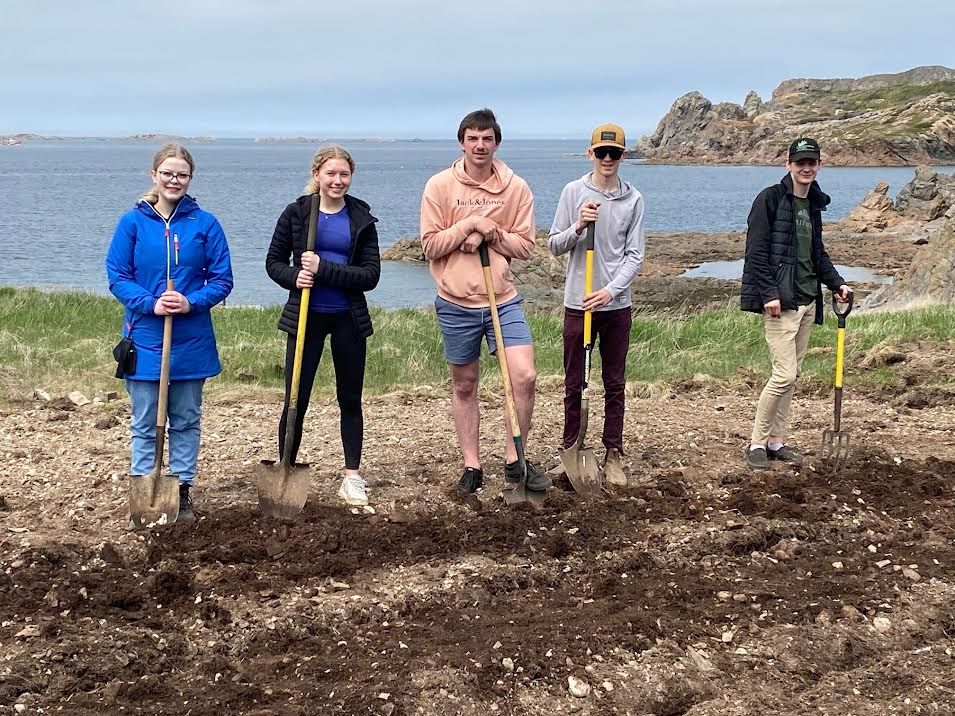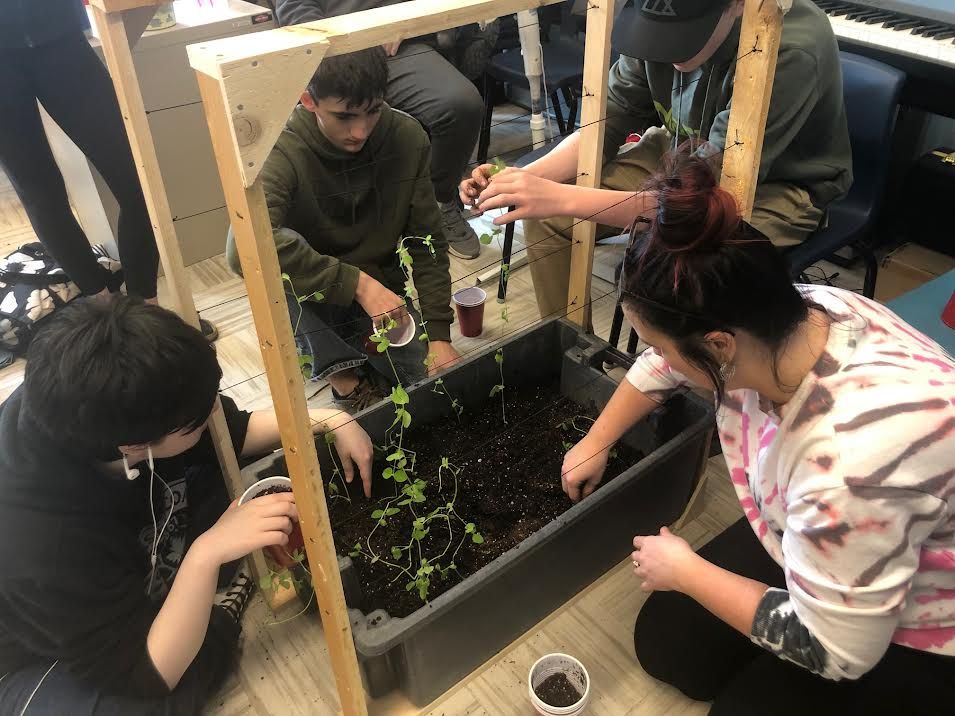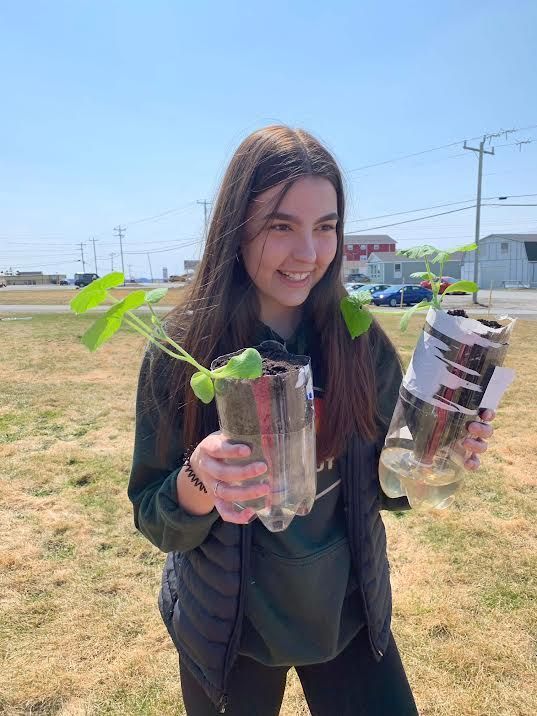What do textiles, bike racks, trees, LEDs, eco-friendly cleaning products, six large planter boxes for square foot gardening, root vegetable gardens dug into the ground, over thirty large containers for growing vegetables, composting, a greenhouse, and an outdoor classroom all have in common? They are all the environmental projects put forth by grades 7 to 12 students at J.M. Olds Collegiate (JMOC) in Newfoundland and Labrador. When an entire student/ teacher body enthusiastically solves environmental problems, the amount of energy becomes astounding. Their actions are leading local communities towards environmental responsibility.
 Principal and home economics teacher, Jessica Granter, explained, “We decided in our Clothing 1101 class to take part in the Clothing 4 Climate initiative that was created by Let’s Talk Science. After completing the lessons in this unit, we had a vision to try our best to make our school more eco-friendly in several different ways including doing our part to reduce greenhouse gas emissions caused by the clothing cycle.” It wasn’t long before Granter’s class began discussing a variety of projects that have since become extremely successful.
Principal and home economics teacher, Jessica Granter, explained, “We decided in our Clothing 1101 class to take part in the Clothing 4 Climate initiative that was created by Let’s Talk Science. After completing the lessons in this unit, we had a vision to try our best to make our school more eco-friendly in several different ways including doing our part to reduce greenhouse gas emissions caused by the clothing cycle.” It wasn’t long before Granter’s class began discussing a variety of projects that have since become extremely successful.
To combat fast fashion, one group began a bi-weekly clothing swap. Teachers joined in the fun by contributing items of high-quality clothing that they no longer found suitable for themselves. The clothing swap encouraged every student to bring in an item or two and leave with something that was new to them. Granter exclaimed, “It’s incredible to see the excitement of students as they not only bring in items but also leave with outfits they love. To make the collection of clothing run smoothly, we created a chute for people to contribute clothing. The chute leads into a little room where students organize the items into sizes and get them ready for display at our next clothing swap.”
Another group created an area in JMOC’s book room for students, staff, and the public to drop off clothing for donations. These students are responsible for bundling clothing to be transported to the Salvation Army Thrift Store in Gander. The school’s Cricut machine was used to make their display fancy and appealing.
A location was created for the school community to be able to contribute clothing not suitable for donation. Here, a group of students cut the materials into rags and delivered them to local auto mechanics.
Other groups have decided to make purses, wallets, bags, etc. from clothing they no longer desire. Students acquired buttons to help design these projects. Many other uses can also be found for fabrics, such as making small bags to gather loose vegetable/fruit produce or to use as gift wraps. Material, along with broken zippers and brass snaps, can be sorted as junk art—purposeful and fun for students to use their imaginations in creating crafts.
What began as a classroom unit developed into the school applying for a Learning for a Sustainable Future (LSF) grant, which was a tremendous help in purchasing the materials for future projects. The grant inspired other classes to develop a variety of other ideas to help reduce carbon emissions such as planting trees on the school property.
Another project to emerge was to make a removable outdoor clothesline that was assembled on two hooks and fastened to the school building. Clothes dryers are huge energy hogs, whereas clotheslines not only save electricity and are gentler on fabrics, but also allow fresh breezes to give textiles a sweet fragrance. This once popular concept that also allows the sun to bleach and sanitize is now utilized many times by students and staff! All of JMOC’s clothing 3Rs ideas are inspiring and illustrate skills that relate to the rising circular economy.
 The skilled trades class built a bike rack to lessen the number of students being driven daily to school. Several teachers are also taking advantage of cycling, which is sparking a new “cool to ride a bike to school” culture. Research has proven that exercise before class sharpens overall brain performance. These students also built gardening boxes and are now constructing picnic tables and benches for an outside learning centre.
The skilled trades class built a bike rack to lessen the number of students being driven daily to school. Several teachers are also taking advantage of cycling, which is sparking a new “cool to ride a bike to school” culture. Research has proven that exercise before class sharpens overall brain performance. These students also built gardening boxes and are now constructing picnic tables and benches for an outside learning centre.
In April, over fourteen varieties of veggie and flower seedlings were planted in the new gardening boxes. The students in the grade 9 home economics class have spent considerable hours learning to take care of each individual plant and realizing that every vegetable, fruit, and flower requires a different type of care. They meticulously built a root vegetable garden and ten students even remained an hour after the last bell to perfect the beds by adding kelp, lime, and topsoil. Besides moving soil and compost, students ran to nearby beaches to harvest kelp, which is one of the richest sources of natural compost in Twillingate.
After receiving approximately $7,000 in grants and donations towards a garden centre, the collegiate also has a greenhouse. What’s more, local businesses are saving all compostable items—students walk to the nearby businesses daily to collect the buckets, dump them in the school bin, and return the buckets!
 Each group took pictures and made commercials regarding their initiatives. One student stated, “Of all the things we’ve ever learned in school, this is the most useful. I’m going home after school today to dig my own potato garden with my father!”
Each group took pictures and made commercials regarding their initiatives. One student stated, “Of all the things we’ve ever learned in school, this is the most useful. I’m going home after school today to dig my own potato garden with my father!”
Granter concluded, “Our Nutrition and NL Studies classes are deep into learning about self-sustainability and will be joining us to plant the rest of our seeds. Many classes have had their hands in this project and will continue to become involved. In fact, the whole community is proud of our efforts. Especially the older generations who are delighted to see that our students are getting back to our roots—and growing our own food, just as they did. Hopefully, the young people of our town will feel confident in their knowledge and ability once again to become a generation who can provide for themselves. We are very proud of our ongoing commitment!”
Related Links
https://www.thespruce.com/reasons-to-line-dry-laundry-2145997
https://momentummag.com/top-10-reasons-you-should-biketo- work/
https://seewhatgrows.org/key-benefits-outdoor-learningeducation-children-teens/
https://www.compostingcouncil.org/page/CompostBenefits
ABOUT THE AUTHOR
Larraine Roulston
Larraine writes children’s illustrated adventure books on composting and pollinating. To view, visit: castlecompost.com.
This article is featured in Canadian Teacher Magazine’s Fall 2023 issue.









